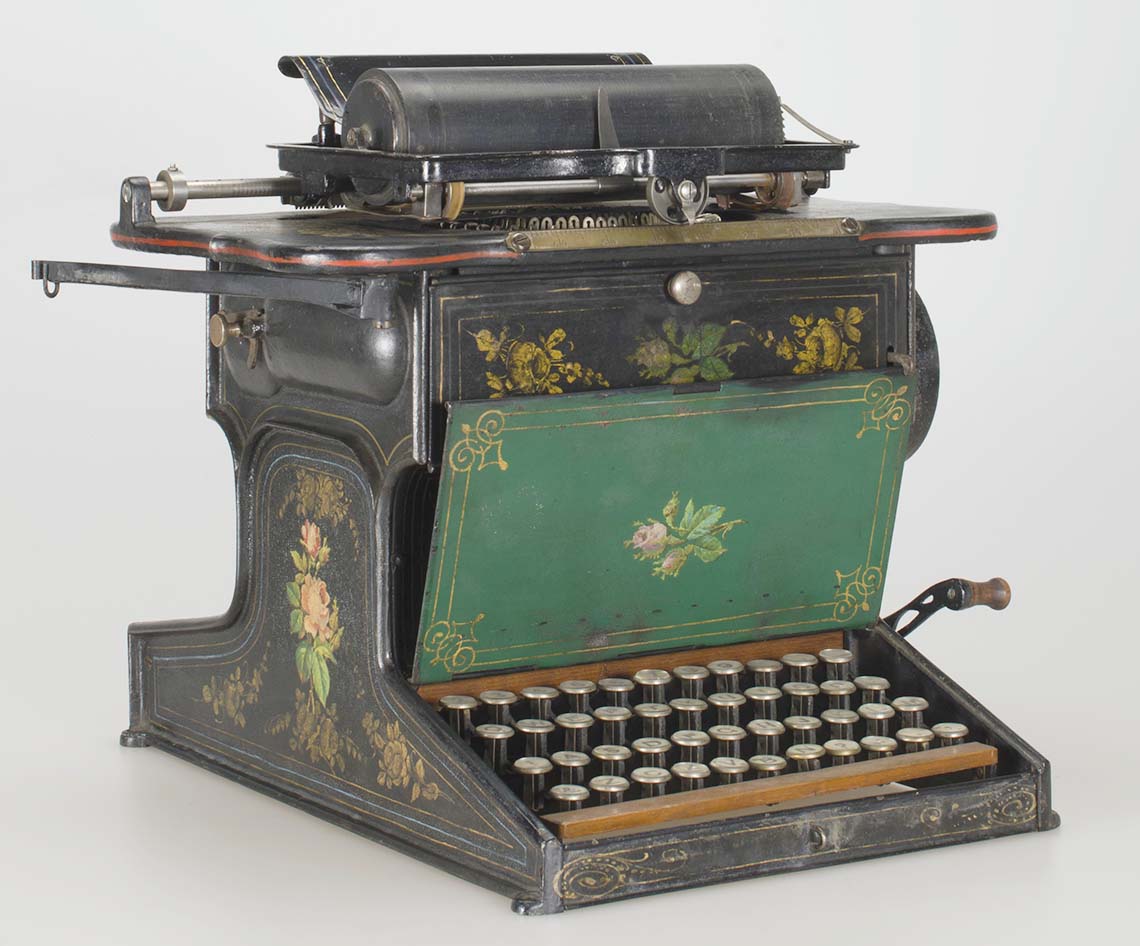4. America, Sholes & Glidden
We will now embark upon the next diorama, where we will meet the American inventor Christopher Latham Sholes, together with his daughter Lili. She was the first secretary to have used a typewriter.
Sholes – a printer and newspaper editor – developed a typewriter together with the illustrator Carlos Glidden and the mechanic Samuel Soulé. The first posters on your left show Kleinsteuber’s workshop where the attempts to build the machine took place. Various models were patented between 1867 and 1868. Initially thanks to collaboration with Philo Remington’s weapons and sewing machine factory, which further developed the models and launched them in 1874, the real foundations were laid for mass production of the typewriter which started its triumphant procession out of America to the rest of the world.
The actual inventors were left empty-handed: while Soulé dropped out of the project very early on, Sholes and Glidden invested nearly all they had in the development of the typewriter and also paid for it with their health. Forced to transfer patent rights to Remington because they were financially ruined, both men died years later from tuberculosis.
In this diorama, in which you can see into an American living room, you will see the “Sholes & Glidden”, the model which appeared on the market. The first batch comprised 25 machines. Each one was hand painted. This machine was intended for private use, while the black and green model on the left was designed for the office. The machines were fitted without a shift lever and therefore only had upper case letters. This was just one of the reasons why it took several years before the machine was really established on the market. Handwriting - a tradition thousands of years old which was a respected profession as early as its Egyptian foundations, was not be given up without resistance. In Mitterhofer’s time, in Austria it was the copyists and imperial scribes and in America the clerks and the secretaries who filled professional typing rooms and enjoyed high social recognition. People did not want to endanger this socially privileged position by operating a machine in a similar way to a factory worker. The secretary was born. Alongside the sewing machine, hardly any other device has had such a lasting effect on professional life and on the emancipation of women as the typewriter. While women from the lower social classes often found themselves working as seamstresses, the daughters of the middle classes were trained to be secretaries. It was not until the turn of the century when training became affordable, even for women in the lower social classes, that the profession of secretary meant climbing the social ladder for many women. See here the expressive illustration with the inventor, Sholes, accepting thanks from the women.
The initial training of women to become “typists”, as the first persons to write using the machines were called in America, was provided by Remington and later by other typewriter manufacturers so that the typing workforce could be advertised with the typewriter, in other words “sold” as a double package. This was very important, since nobody knew how to use a typewriter.
One of the first buyers of a Remington typewriter shortly after they appeared on the market in 1874 was Mark Twain. He was the first writer to use a typewriter and also one of the first to recognise the benefits of the typewriter over handwriting. It took several more years for the typewriter to stand its ground in the market. It was not until the mid 1880s that the first teething troubles were eliminated and sales figures rose rapidly.
Within a very short time, the number of companies manufacturing typewriters multiplied. The models displayed here provide an insight into the early history of the typewriter. The names on the typewriter models enable you to detect how patent rights were managed or how attempts were made to circumvent these. Nearly all these first machines function according to a down-stroke principle which is already characterised in Mitterhofer’s model. The theory supported by Granichstaedten-Czerva that the Americans copied Mitterhofer's idea can no longer be seen as valid today. Here, it is more a question of a parallel development, as was often the case with other inventions.
The principle of a full keyboard was used by Mitterhofer and used here by Smith Premier, Yost, Caligraph and others. After decades of battling with advertising, at the beginning of the 20th Century those typewriters with a shift mechanism finally won the day.

4. America, Sholes & Glidden

Pilot intervention in South Tyrol co-financed by the Cassa di Risparmio di Bolzano Foundation





